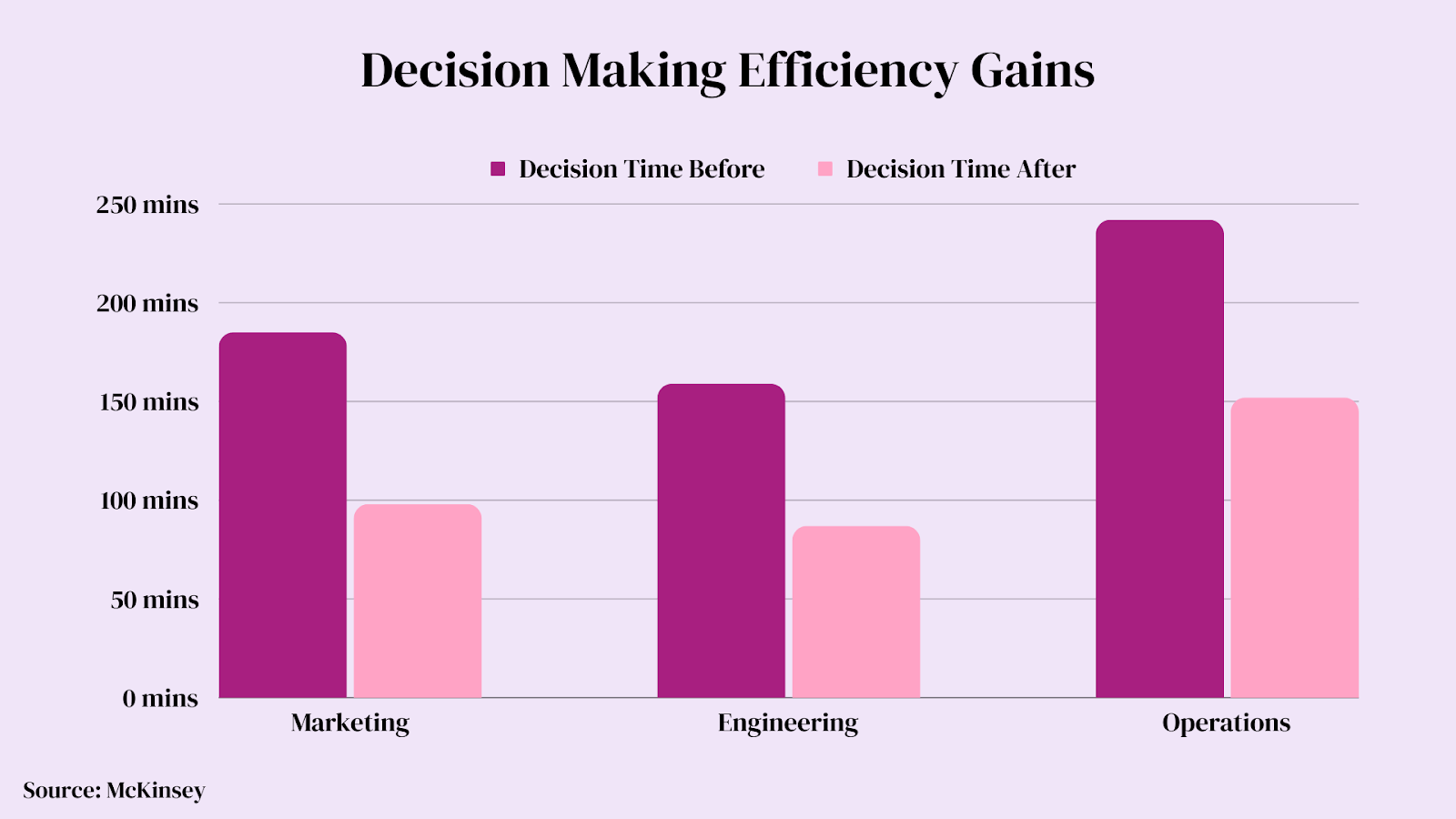Decision trees have become a vital tool for tech companies aiming to increase their revenue in today’s complex world full of data. From improving customer satisfaction to streamlining internal operations, interactive decision trees that use data-based insights give tech companies an edge over the competition.
The Strategic Importance of Interactive Decision Trees in Tech Companies
Decision trees play a big part in shaping the strategic choices of tech companies. A Harvard Business Review study found that companies using advanced analytics, including decision trees, made 6-14% more profits than companies not using such tools. This demonstrates how data-driven decision trees can significantly increase profits.
By mapping out different situations and possible outcomes, decision trees help leaders make the best choices. Whether deciding resource splits, product plans, market moves, or company buys, decision trees bring data-driven insights into strategic thinking. Big tech companies like Microsoft, Google, and IBM actively use interactive decision trees for long-term situation planning, showing their value.
Interactive decision tree software not only optimizes single decisions but aligns them to the overarching company strategy powered by data-based insights.
Enhancing Customer Experience through Interactive Decision Trees
While bettering inner plans is key, using decision trees also greatly improves customer experience. By mapping out different customer trips, interactive decision trees provide fitted ideas and personal interactions. According to one study, implementing this in customer-facing processes can increase satisfaction scores by up to 20%.
Leading tech companies like Dell, HP, and Lenovo have put decision trees into their customer support portals to provide tailored troubleshooting help. Customers simply answer some questions about the issues they face and get targeted solutions based on the decision tree’s data-backed logic.
These personalized and streamlined interactions lead to more satisfied customers. Even tricky B2B sales processes involving many decision-makers across organizations can be bettered using business-grade decision trees.
We’ve been able to greatly enhance customer experience across sales and support by using data-driven decision trees to match interactions.
Streamlining Internal Processes with Decision Trees
Adding decision trees into a company’s inner workflows makes things run much more efficiently. According to research, using decision trees lowers the average time managers take to decide things! Take a look at the data below, which illustrates the difference in decision-making time for managers before and after using decision trees:

Mapping Out Choices
Decision trees simplify complex choices by presenting them in straightforward flowcharts. This makes big decisions easier by showing step-by-step logic based on company data inputs.
Faster Decisions Across Departments
HR, engineering, production, and more can all optimize daily choices on stuff like task timing, people and money allocation, progress tracking, new hiring, budgets, and much more.
Smarter Development Cycles
An aerospace maker made a multi-layer decision tree to guide engineering prototype selections using real-time design test data, cost reviews, and production readiness markers. This sped up poor choice cycles by over 40%!
Nimble Leadership Planning
Decision tree models let strategy teams simulate situations super quickly to stress test future plans in interactive workshops. Tools like Claude allow executives to feed in key data assumptions and get structured what-if analyses in real-time.
With over 80% of Fortune 500 companies now using data-driven decision trees internally, they clearly make tech businesses run faster and beat the competition!
Data-Driven Insights: The Backbone of Effective Decision Trees
The powerful perks given by decision trees finally depend on the quality of data-based insights used. IBM research shows that combining big data and advanced analytics can make decision tree accuracy 35% better.
By monitoring extensive data on customer actions, market dynamics, production metrics, and more, and applying complex predictive modeling, decision trees can model situations more precisely. Leaders can continually refine decision trees using newly streaming data.
Many tech titans like Adobe, SAP, and Salesforce use real-time big data pipelines to build business-grade decision trees which change through machine learning codes. Such adaptive and smart decision trees power up data-driven decision-making.
Rather than relying on intuition, our leaders actively utilize data-backed decision trees in our strategic and operational workflows to base our choices on facts and logic.
The Evolving Future: AI and Machine Learning in Decision Trees
As the adoption of decision trees in tech companies accelerates, so does the development of advanced apps incorporating artificial intelligence and machine learning. IDC forecasts over 65% of company decision trees will be AI-powered by 2025.
Tech companies are heavily investing in research related to adaptive decision trees, which continually improve ideas through automated data review, rather than relying solely on rules-based modeling.
Reinforcement Learning
Reinforcement learning lets decision trees be scored on outcomes and continually refine game plans to maximize positive results. For example, Stripe built a reinforcement learning model for its sales-based decision tree to guide which customers to put forward its premium services to. By always upgrading standards based on profit lift, it bettered results over regular decision tree logic.
Graph Theory & Evolutionary Algorithms
Also, graph-based evolutionary algorithms empower decision trees to view exponentially more trials based on emerging data – far beyond human ability. Google Brain has been pioneering research applying powerful graph neural webs for decision order guesswork across areas like shipping, genomics, and even chip design with promising results.
Hybrid AI Approaches
Searching synergistic machine learning techniques like combining reinforcement learning, graph theory, pretend play and natural language is heating up. Startups like NeuroMesh and Paradox Engine are in the lead of building business hybrid AI which takes decision trees into wide-open new regions for recommendation frameworks.
These diverse uses of AI and ML techniques will define the future of automated and intelligent decision support systems. Leading cognitive computing firm IPsoft reports revolutionary gains across client companies from its AI-powered decision tree solutions, showing a peek into the future. The surface has only just been scratched so far in leveraging AI’s potential to change decision trees.
AI decision trees will become the killer app for tech companies. They will shake up how we model data, enable prediction at scale, enhance choices, and make augmented, hyper-personalized verdicts.
Key Considerations for Implementation
To fully use decision trees, tech companies need to ensure they have the right beginnings before rollout:
- Integrated Data Infrastructure: Linking separated data sources into a connected building ensures decision trees can simply access company data. APIs also enable external market data intake.
- Analytical Capabilities: Tools such as SQL, Python, and R for statistical modeling and machine learning coding enable the construction of long-lasting decision trees. Growing data science skills inside is key.
- Governance Frameworks: Rules for ethics, clarity, and explanatory documents make for transparent and fair decision tree modeling – vital for adoption.
- Agile Workflows: Bendable deployment plans, user feedback loops and repetitive upgrading based on outcomes are key for long-term decision tree success and positive ROI.
FAQs
How do interactive decision trees directly change profitability in tech companies?
By facilitating data-backed strategic planning, enhancing customer interactions, and improving operational efficiency, decision trees directly enhance tech company profits across various metrics, from income growth to cost control.
What are the main challenges in carrying out decision trees in a tech company?
Ensuring C-suite support, cleaning data infrastructure, building strong analytical models, aligning processes, tracking outcomes, and encouraging user adoption are all pivotal for successful rollout.
How can AI and machine learning boost decision trees for tech companies?
By enabling real-time optimization, predictive customization at scale, computerized situation modeling, machine learning codes, and simulation of knotty systems, AI will revolutionize decision trees – taking them from rigid flowcharts to bendy smart helpers.
Conclusion and Key Takeaways
Decision trees are crucial for tech companies seeking bigger profits today. These data-powered flowcharts help leaders make smarter planning choices.
Decision trees boost profits by guiding better strategy, improving customer happiness to drive sales, and speeding up inner company work. Future artificial intelligence will make them even smarter.
Top tech companies must start using data-based decision trees now or risk falling way behind the competition that’s embracing them. Interactive decision trees represent a ‘magic formula’ that has the potential to significantly increase profits!












